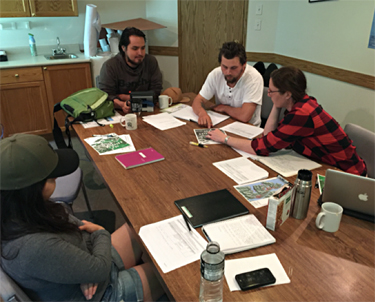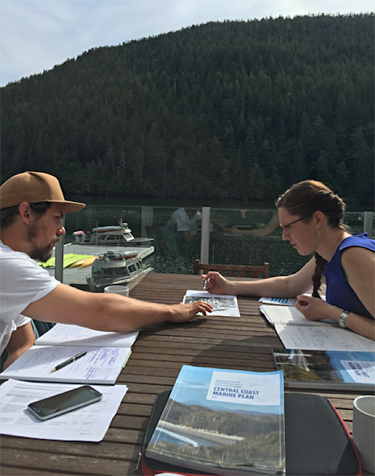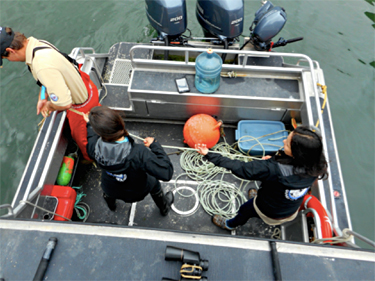
(Clockwise from top) Vernon Brown, Curtis Rollie, Anna Gerrard, and Chantal Pronteau review MaPP deliverables, discussing objectives and required actions and outcomes. Photo credit: Gord McGee.
First Nations people have long understood that the use of natural resources needs to be carefully managed in order to remain sustainable. They recognize that species, ecosystems and humans cannot be considered in isolation – healthy environments and healthy communities go hand-in-hand. This has been a guiding principle in their relationship with nature for thousands of years. Today, the Coastal First Nations – Great Bear Initiative Coastal Stewardship Network is supporting First Nations in using monitoring and standardized data collection to demonstrate scientifically why this approach, known as ecosystem-based management (EBM), is so important to preserving the lands and waters for future generations.
Chantal Pronteau and Curtis Rollie are guardian watchmen in the Central Coast’s Kitasoo/Xai’Xais Nation. This is the second year they have been monitoring and protecting their territory’s natural resources. Both live in Klemtu but are stationed in remote Mussel Inlet for three months of the year and spend an additional three months monitoring the rest of their Nation’s vast area.
With support from the Marine Plan Partnership (MaPP), Rollie and Pronteau took the first level of the Coastal First Nations Stewardship Technicians Training Program and are now participating in Level 2. The training includes 14 courses that develop a variety of skills including environmental compliance and monitoring.

Kitasoo/Xai’Xais Nation Guardian Watchman Curtis Rollie (left) and Marine Plan implementation coordinator Anna Gerrard go over the upcoming guardian watchman schedule and responsibilities. Photo credit: Gord McGee.
“The training made a huge difference to how we do our work,” says Pronteau. “It made me more comfortable in my role as a watchman. This is work that can’t be done from a desk; we are the stewards of this land.”
“I’ve learned what to look for when patrolling, how to approach people so they feel welcome, and how to enforce First Nations laws,” says Rollie. “The small motors course has been valuable as we rely on our boats every day to accomplish our tasks.”
EBM monitoring is a priority for near-term implementation of the MaPP Central Coast Marine Plan, and Rollie and Pronteau collect data to support a variety of indicators including key species as well as noting human pressures on the ecosystem. They enter their findings on tablets and upload the information to the Coastal First Nations Regional Monitoring System (RMS).
“We’ll enter how many crab traps we see and where they are, how many boats we see and what they’re doing,” says Rollie. “We’ll record locations of logging and fishing tenures to monitor whether they’re operating in the right zone. We’ve done a rockfish survey where we count all the fish we catch in a 15-minute span and document all of them. We record water temperature, salinity and pH levels. We have a long list of things to check and all these indicators show us how everything is interconnected.”
Lara Hoshizaki administers the database that guardian watchmen such as Pronteau and Rollie upload information to. As the regional monitoring system coordinator, she works closely with the six Coastal First Nations that use the RMS and provides monthly reports.

Kitasoo/Xai’Xais Nation Guardian Watchmen Curtis Rollie (left) and Chantal Pronteau (right) work with the Coastal Stewardship Network’s training coordinator Elodie Button (centre) to measure ocean pH in their Nation’s territory. Photo credit: Curtis Rollie.
“A standardized system is able to provide a more accurate regional picture,” says Hoshizaki. “The data collected support Nations in studying and communicating what’s happening in their territories in a quantifiable way and also support ongoing scientific research, for example, the trap sighting data collected by the RMS is shared with the Central Coast Indigenous Resource Alliance for use alongside their ongoing Dungeness Crab research. EBM monitoring offers a holistic picture by looking at a broad suite of indicators related to ecological, economic, social and cultural well-being, and can provide solutions from several perspectives.”
An EBM framework guides the implementation of many of the MaPP strategies and the work the guardian watchmen perform is important to its success. Through training, MaPP is building capacity to collect data related to EBM indicators. This improves monitoring and enforcement and measures long-term changes in ecological and human well-being.



